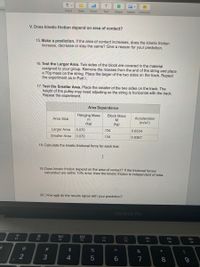Question

Transcribed Image Text:Page
Insert
Table
Chart
Text
Shape
Media
Comment
V. Does kinetic friction depend on area of contact?
15. Make a prediction. If the area of contact increases, does the kinetic friction
increase, decrease or stay the same? Give a reason for your prediction.
16. Test the Larger Area. Two sides of the block are covered in the material
assigned to your group. Remove the masses from the end of the string and place
a 70g mass on the string. Place the larger of the two sides on the track. Repeat
the experiment as in Part I.
17. Test the Smaller Area. Place the smaller of the two sides on the track. The
height of the pulley may need adjusting so the string is horizontal with the track.
Repeat the experiment.
Area Dependence
Hanging Mass
Block Mass
Area Size
Acceleration
m
M
(kg)
(kg)
(m/s2)
Larger Area
0.070
134
0.6534
Smaller Area
0.070
.134
0.9387
18. Calculate the kinetic frictional force for each trial.
19. Does kinetic friction depend on the area of contact? If the frictional forces
calculated are within 10% error, then the kinetic friction is independent of area.
20. How well do the results agree with your prediction?
MacBook Pro
000
000
F1
F2
F3
DD
F4
F5
F6
F7
F8
F9
#3
2$
&
2
4
7
8
Expert Solution
This question has been solved!
Explore an expertly crafted, step-by-step solution for a thorough understanding of key concepts.
This is a popular solution
Trending nowThis is a popular solution!
Step by stepSolved in 2 steps with 1 images

Knowledge Booster
Similar questions
- x Incorrect The force P is applied to the 30-kg block when it is at rest. Determine the magnitude and direction of the friction force exerted by the surface on the block if (a) P = 0, (b) P = 85 N, and (c) P = 131 N. (d) What value of P is required to initiate motion up the incline? The static and kinetic coefficients of friction between the block and the incline are us = 0.18 and µk = 0.12, respectively. The friction force is positive if up the incline, negative if down the incline. %3D P 30 kg 18° H, = 0.18 H = 0.12 12 Answers: (а) F 3D N (b) F (c) F = (d) P =arrow_forwardWhat is the terminal speed of a 7.11 kg spherical ball that has a radius of 1.69 cm and a drag coefficient of 1.38? The density of the air through which the ball falls is 1.20 kg/m³. Number i Unitsarrow_forwardA uniform wire with mass M and length L is bent into a semicircle. Part A Find the magnitude of the gravitational force this wire exerts on a point with mass m placed at the center of curvature of the semicircle. Express your answer in terms of G, M, m, L, and T. F =arrow_forward
- The block shown in figure #1 above has a mass of 4.30 kg. The applied force (? ⃑ ) has a magnitude of 31.2 N and is 32.0° above the horizontal, frictionless surface the block in on. a. What is the force of gravity (magnitude and direction) that acts on the block? b. What is the y-component of the block’s acceleration?arrow_forwardP1a please help me with the answer and full solutionarrow_forwardA A Your Answer: L1 100 N L2 A rigid mass-less beam rests on two supports as shown. On the beam a force of 145 N is applying at a distance L1 = 0.1 m from support A. Support B is L2 = 1.7 m from the force 145 on the beam. Determine the reaction force at A. Barrow_forward
- A small block with mass 0.0450 kg slides in a vertical circle of radius 0.0710 m on the inside of a circular track. There is no friction between the track and the block. At the bottom of the block's path, the normal force the track exerts on the block has magnitude 3.70 N Part A What is the magnitude of the normal force that the track exerts on the block when it is at the top of its path?arrow_forward12. A 24 lb sign is hung from above and from the side by two light and non-stretchable cables. Each cable is attached to the top-center of the sign. The left most extending to the ceiling an angle of 56 degrees relative to the leftwards horizontal direction. The second cable is attached to an adjacent wall horizontally. What is the tension in the horizontal cable? a. 0 lbs b. 12 lbs 16 lbs 24 lbs C. d.arrow_forwarda. What is the x-component of this force? answer in N b. What is the y-component of this force? answer in Narrow_forward
arrow_back_ios
arrow_forward_ios